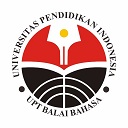Application of Differentiated Instruction on Japanese Language Proficiency Test to Build Students’ Awareness of Lifelong Learning
Abstract
Along with the rapid development of technology and the occurrence of education 4.0, lifelong learning ability becomes an important element in 21st century learning. Lifelong learning ability consists of the ability to develop strategies and evaluate one’s own learning, to improve knowledge, skills, and competence, so that continuous and sustainability learning habit can be built. By applying lifelong learning, students can evaluate their own learning, recognize their weaknesses and strengths, so that they can design the right learning model for the development of their knowledge. The ability to do lifelong learning is very important to be mastered by a student, so the teacher should introduce this learning model to student. On the other hand, as teacher we also conduct classroom / group learning that the differences in student’s ability may vary in one class. It needs to be facilitated by designing student personal learning (Differentiated Instruction / DI) to maximize student outcome. This paper discusses how DI strategies that implemented in Japanese Language Proficiency Test: Intermediate Level (Noryoku Shiken III) courses can build student awareness of lifelong learning. The participant of this research is the student from Japanese Language Proficiency Test: Intermediate Level (Noryoku Shiken III) class in Japanese Department, in a private university in Jakarta. The result of this research is after applying DI, a good progress was seen in each student towards the achievement of JLPT N3 grades, and can create independent learning habits, so students can sustain this learning habits even after finishing this subject.
Keywords
Full Text:
PDF (ENG)References
ASEAN University Network. (2015). Guide to AUN-QA Assessment at Programme Level. Bangkok.
Badan Akreditasi Nasional PerguruanTinggi. (2017). Peraturan Badan Akreditasi Nasional Perguruan Tinggi Nomor 4 Tahun 2017 Tentang Kebijakan Penyusunan Instrumen Akreditasi Akreditasi. Jakarta.
Delisio, E, R. (2010). Developing Differentiated Roles for Effective Teachers. Retrieved from Association for Supervision and Curriculum Development: http://www.ascd.org/publications/newsletters/education-update/feb10/vol52/num02/Developing-Differentiated-Roles-for-Effective-Teachers.aspx .
Demirel, M. (2009). Lifelong learning and schools in the twenty-first centurys. Procedia Social and Behavioral Sciences. 1 (2009) 1709–1716
Gandhi, P, O. (2017). Outcome Based Focused Education Overview. Retrieved from ResearchGate: https://www.researchgate.net/publication/317209834_Outcomes_Based_Education.
Kataoka, H, C. (2012). Differentiated instruction in Japanese language classes. Proceedings of National Symposium on Japanese Language Education. Sydney, Australia.
Kementrian Pendidikan dan Kebudayaan. (2020). Merdeka Belajar: Kampus Merdeka. Jakarta.
London, M. (2011). Lifelong Learning: Introduction. The Oxford Handbook of Lifelong Learning: Mar 2011, 3. Retrieved from Oxford Handbooks Online: https://www.oxfordhandbooks.com/view/10.1093/oxfordhb/9780195390483.001.0001/oxfordhb-9780195390483-e-001
Reese, S. (2011). Differentiation in the Language Classroom: HOW DO YOU SUPPORT EVERY LEARNER? The Language Educator. Vol 6, Issue 4, August 2011 40-46
Sari, W, K, and Wilujeng, I. (2020). Education change in the industry 4.0: Candidate science teacherperspective. Journal of Physics: Conference Series. 1440 (2020) 0120902
Spady, W, G. (1994). Outcomes Based Education: Critical Issues and Answers. American Association of School Administration. Arlington
Subban, P. (2006). Differentiated instruction: A research basis. International Education Journal. Vol 7, Issue 7, 2016 935-947
Smets, W. (2017). High Quality Differentiated Instruction – A Checklist for Teacher Professional Development on Handling Differences in the General Education Classroom. Universal Journal of Educational Research. Vol 5, Issue 11, 2011 2074-2080.
The Japan Language Education Center. JLPT Study Hour Comparison Data 2010-2015. Retrieved from https://web.archive.org/web/20151117033458/http://www.studytoday.com/JLPT.asp?lang=EN on 2020, May 6
Westman, L. (2018). DIFFERENTIATED INSTRUCTION: Succeeding With Differentiation. Retrieved from Edutopia: https://www.edutopia.org/article/succeeding-differentiation
Westwood, P. (2016). Teaching Methods: Differentiated instruction. Retrieved from Teacher Magazine:https://www.teachermagazine.com.au/articles/teaching-methods-differentiated-instruction
DOI: https://doi.org/10.17509/japanedu.v6i2.36808
Refbacks
- There are currently no refbacks.
Copyright (c) 2021 JAPANEDU: Jurnal Pendidikan dan Pengajaran Bahasa Jepang

This work is licensed under a Creative Commons Attribution-ShareAlike 4.0 International License.
 Published by:
Published by: Department of Japanese Language Education, Faculty of Language and Literature Education
Universitas Pendidikan Indonesia
 Online ISSN: Online ISSN:2528-5548 |

JAPANEDU: Jurnal Pendidikan dan Pengajaran Bahasa Jepang (e-ISSN:2528-5548) lisenced under a Creative Commons Attribution-ShareAlike 4.0 Internasional (CC BY-SA 4.0)


